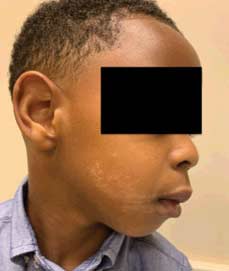4-year-old boy presents with bumpy facial rash

A 4-year-old boy presents with a bumpy rash on the right side of his face for the past 5 months. The rash is neither pruritic nor painful. Before onset of the rash, he had a cavity treated. He is in day care with another child who was seen by a dermatologist for bumps on the skin that were treated with a cold liquid. Hydrocortisone 1% cream was tried for 2 weeks without clearance of the lesions.
Can you spot the rash?
A. Inflammatory linear verrucous epidermal nevus
B. Flat warts
C. Lichen striatus
D. Herpes zoster
E. Molluscum


Lichen striatus (correct choice, C) is a benign, linear, inflammatory condition of the skin (Figure 1). Although our patient was male, lichen striatus most frequently affects young girls, with a mean age of onset at 4 years. The etiology is unknown, but it has been associated with viral infections, hepatitis B vaccination, trauma and atopy.
The classic presentation is an asymptomatic linear or curvilinear band comprising small erythematous to hypopigmented flat-topped papules. This unilateral band follows along Blaschko’s lines, which represent the pathways of epidermal cell migration during fetal development. The onset is usually sudden, progressing over a few weeks. A single limb is most commonly affected, with extension along the extremity and onto the nail. Our patient had involvement of the face, which is a less frequently affected area. In darker skin types, scaling and hypopigmentation can be the predominate findings, as was seen in this patient
The differential diagnosis includes inflammatory linear verrucous epidermal nevus (ILVEN), which also presents as a linear eruption along Blaschko’s lines. However, ILVEN tends to be more pruritic, looks like psoriasis with thicker scaly lesions and does not spontaneously remit. Other linear eruptions to consider include verruca plana (flat warts), linear porokeratosis and linear forms of inflammatory skin diseases such as psoriasis, lichen planus and cutaneous lupus erythematosus. A skin biopsy can help distinguish between these conditions but is not typically necessary. The curvilinear distribution of flat-topped papules along Blaschko’s lines is often the most helpful diagnostic clue.
Lichen striatus is a self-resolving condition. It tends to heal with post-inflammatory hypopigmented areas that eventually fade over time. Treatment is not necessary because the condition will usually spontaneously resolve within 1 to 2 years. If the lesions do not self-resolve, a skin biopsy should be considered to aid in determining an alternative diagnosis. Although most forms of lichen striatus do not respond to treatment, facial lesions have been reported to respond to topical tacrolimus. Topical steroids can be used to alleviate pruritus but will not shorten the disease duration. Our patient was asymptomatic and opted for observation.
- References:
- Paller AS, Mancini AJ. Eczematous eruptions in childhood. In: Paller AS, Mancini AJ, eds. Hurwitz Clinical Pediatric Dermatology. 5th ed. Edinburgh: Elsevier; 2016:38-72.
- Patrizi A, et al. Pediatr Dermatol. 2004;doi:10.1111/j.0736-8046.2004.21302.x.
- Peramiquel L, et al. Eur J Pediatr. 2006;doi:10.1007/s00431-005-0032-9.
- For more information:
- Michele Khurana, MD, is a pediatric dermatology fellow at The Children’s Hospital of Philadelphia. She can be reached at khuranam@email.chop.edu.
- Marissa J. Perman, MD, is an attending physician at The Children’s Hospital of Philadelphia.
Disclosures: Khurana and Perman report no relevant financial disclosures.



